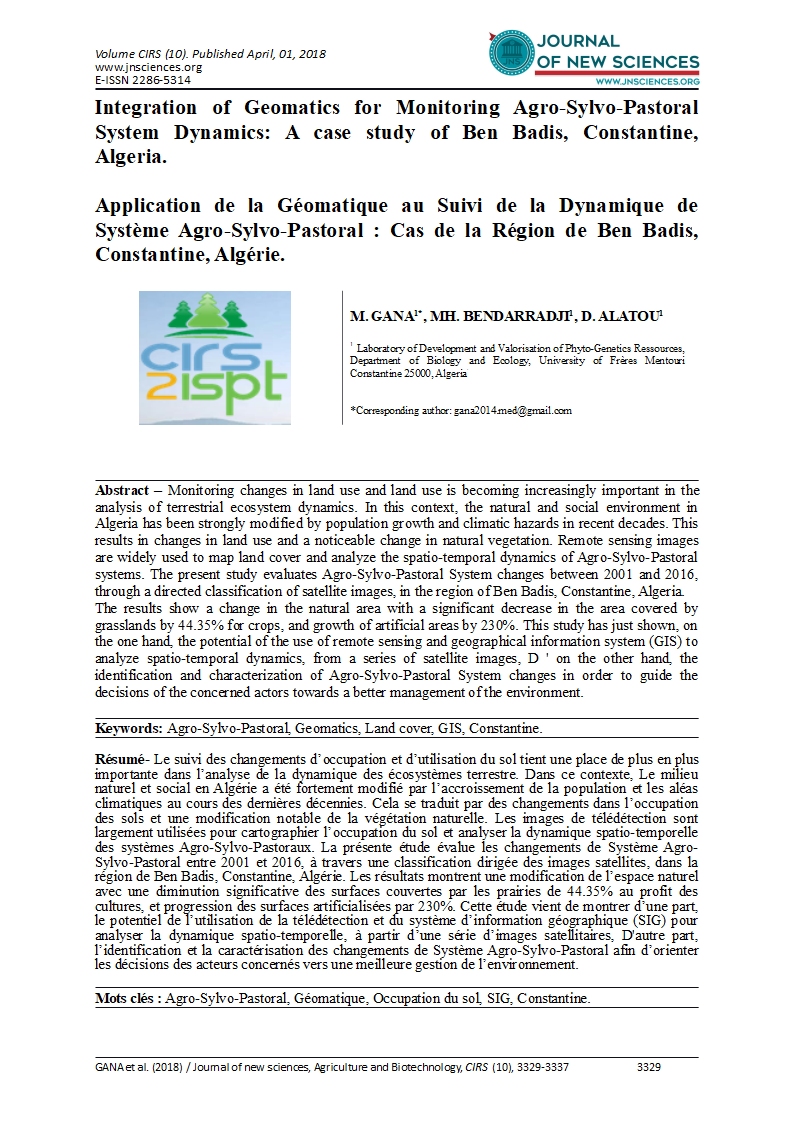

- Category: VOLUME SPÉCIAL (CONFÉRENCE CIRS 2017)
- Hits: 10161
Integration of Geomatics for Monitoring Agro-Sylvo-Pastoral System Dynamics: A case study of Ben Badis, Constantine, Algeria.
Application de la Géomatique au Suivi de la Dynamique de Système Agro-Sylvo-Pastoral : Cas de la Région de Ben Badis, Constantine, Algérie.
|
|
M. GANA1* MH. BENDARRADJI1 D. ALATOU1
1 Laboratory of Development and Valorisation of Phyto-Genetics Ressources, Department of Biology and Ecology, University of Frères Mentouri Constantine 25000, Algeria. |
Abstract – Monitoring changes in land use and land use is becoming increasingly important in the analysis of terrestrial ecosystem dynamics. In this context, the natural and social environment in Algeria has been strongly modified by population growth and climatic hazards in recent decades. This results in changes in land use and a noticeable change in natural vegetation. Remote sensing images are widely used to map land cover and analyze the spatio-temporal dynamics of Agro-Sylvo-Pastoral systems. The present study evaluates Agro-Sylvo-Pastoral System changes between 2001 and 2016, through a directed classification of satellite images, in the region of Ben Badis, Constantine, Algeria. The results show a change in the natural area with a significant decrease in the area covered by grasslands by 44.35% for crops, and growth of artificial areas by 230%. This study has just shown, on the one hand, the potential of the use of remote sensing and geographical information system (GIS) to analyze spatio-temporal dynamics, from a series of satellite images, D ' on the other hand, the identification and characterization of Agro-Sylvo-Pastoral System changes in order to guide the decisions of the concerned actors towards a better management of the environment.
Keywords: Agro-Sylvo-Pastoral, Geomatics, Land cover, GIS, Constantine.
Résumé- Le suivi des changements d’occupation et d’utilisation du sol tient une place de plus en plus importante dans l’analyse de la dynamique des écosystèmes terrestre. Dans ce contexte, Le milieu naturel et social en Algérie a été fortement modifié par l’accroissement de la population et les aléas climatiques au cours des dernières décennies. Cela se traduit par des changements dans l’occupation des sols et une modification notable de la végétation naturelle. Les images de télédétection sont largement utilisées pour cartographier l’occupation du sol et analyser la dynamique spatio-temporelle des systèmes Agro-Sylvo-Pastoraux. La présente étude évalue les changements de Système Agro-Sylvo-Pastoral entre 2001 et 2016, à travers une classification dirigée des images satellites, dans la région de Ben Badis, Constantine, Algérie. Les résultats montrent une modification de l’espace naturel avec une diminution significative des surfaces couvertes par les prairies de 44.35% au profit des cultures, et progression des surfaces artificialisées par 230%. Cette étude vient de montrer d’une part, le potentiel de l’utilisation de la télédétection et du système d’information géographique (SIG) pour analyser la dynamique spatio-temporelle, à partir d’une série d’images satellitaires, D'autre part, l’identification et la caractérisation des changements de Système Agro-Sylvo-Pastoral afin d’orienter les décisions des acteurs concernés vers une meilleure gestion de l’environnement.
Mots clés : Agro-Sylvo-Pastoral, Géomatique, Occupation du sol, SIG, Constantine.

